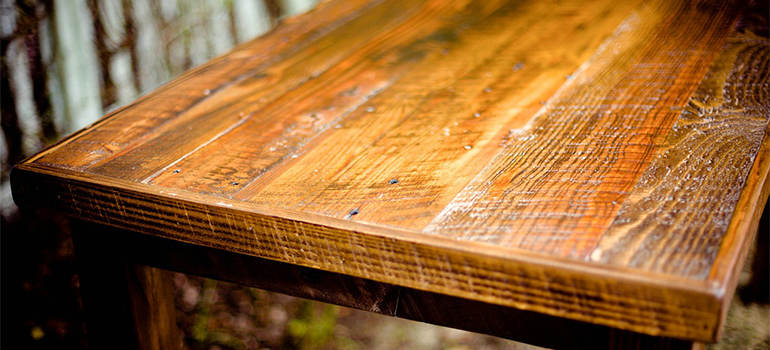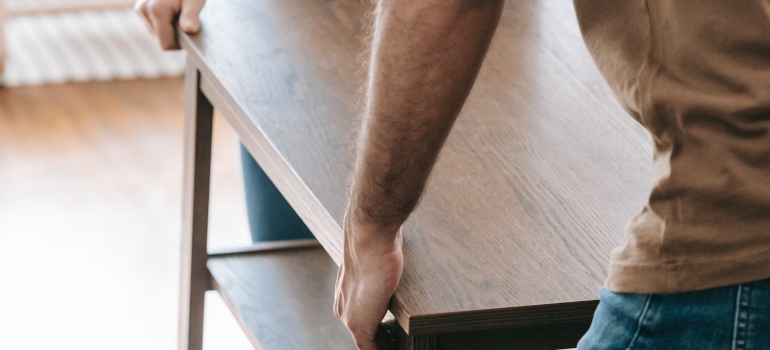Protecting Wooden Items During Transport – How to Do It
Wooden furniture and decorative items bring warmth and character to any space, but when it comes to transporting them, they require special care. Unlike metal or plastic, wood is an organic material—prone to scratches, warping, moisture damage, and impact-related cracks. Protecting wooden items during transport requires a strategic approach—one that considers the unique vulnerabilities of wood, the right materials for protection, and techniques that minimize risk throughout the journey. We’ll explore why wood requires extra attention, how to prepare and pack it properly, and the best ways to secure it inside a moving vehicle. By the end of our Hansen Bros. Moving & Storage guide, you’ll have a clear understanding of how to move wooden furniture and décor safely, ensuring they arrive at their destination unscathed.
Understanding the Vulnerabilities of Wooden Items
Wood is a natural, organic material, and this makes it far more delicate than it may appear. It reacts to its surroundings, making it prone to expansion, contraction, and damage from sudden impacts. Unlike other materials, once wood sustains damage, restoring it can be a long and costly process, especially for antique or hand-carved pieces.
Why Wood Requires Special Care
One of the biggest challenges with transporting wooden items is their sensitivity to environmental changes and physical impact. While metal and plastic furniture can often withstand bumps and shifting, wood is highly reactive. Moisture exposure can lead to swelling, while dry conditions may cause cracks. Sudden temperature changes can force wood to expand and contract, resulting in warping or structural weakening.
Additionally, wood surfaces are easily scratched or dented, particularly if they have a polished or varnished finish. Even a slight brush against another hard surface can leave a visible mark. Furniture legs and joints are particularly vulnerable, as they often bear significant weight and can crack under stress if not supported properly.

Types of Wooden Items and Their Challenges
Different types of wooden furniture and décor require unique protection strategies. Solid wood furniture, though durable, can be extremely heavy, which increases the risk of damage if it shifts during transport. Veneered furniture, common in modern designs, has a thin outer wood layer that is prone to chipping and peeling.
Antique wooden pieces are even more fragile, often featuring intricate carvings that can easily snap if not properly cushioned. Smaller wooden items, such as sculptures or decorative frames, are susceptible to breakage if packed too loosely, as even minor vibrations can cause them to crack.
Pre-Transport Preparation – The Key to Preventing Damage
Before a wooden item is packed by your chosen Washington movers, it must be properly prepared. Many people assume that wrapping furniture at the last minute is enough, but without careful preparation, even the best packing materials may not provide sufficient protection. This stage is essential in ensuring that wooden items are clean, disassembled if necessary, and wrapped using appropriate materials.
Cleaning Before Packing
A crucial but often overlooked step is cleaning wooden furniture before transport. Dust and dirt particles may seem harmless, but when trapped under protective wrapping, they can cause abrasions on polished surfaces. Additionally, any existing moisture on wood can lead to mold growth if sealed improperly.
To prevent this, wipe down surfaces with a soft, dry cloth or, for more stubborn dirt, a slightly damp cloth with a mild wood cleaner. However, avoid excessive moisture, as it can weaken the wood fibers. Once you clean the item, leave it to fully air-dry before wrapping.
Disassembling for Safer Handling
Disassembling large wooden furniture helps reduce stress on joints, prevent breakage, and make transport more manageable. While not all pieces can be taken apart, those that can—such as tables, bed frames, and cabinets—should be broken down into smaller components to minimize the risk of structural damage.
For example, removing a table’s legs significantly reduces the likelihood of snapping or bending during transport. Similarly, drawers should either be removed or securely fastened to prevent them from sliding out unexpectedly. Store any screws, bolts, or small hardware pieces in labeled plastic bags for easy reassembly later.
Choosing the Right Packing Materials
Selecting the correct packing materials and moving boxes in Seattle is crucial for protecting wooden items during transport. Unlike plastic or metal, wood requires a combination of cushioning and breathable coverage to prevent moisture buildup and surface damage:
- Moving blankets provide thick, padded protection against impact.
- Foam padding helps safeguard intricate carvings and delicate wooden details.
- Corrugated cardboard acts as a buffer between wooden surfaces and other objects.
- Stretch wrap can be perfect to hold padding in place but never apply it directly to wood, as it can trap moisture.
The goal is to wrap wooden items in layers, starting with a soft, breathable material before adding outer reinforcements.

Proper Packing Techniques for Maximum Protection
Packing is the most critical step in protecting wooden furniture, as even the best loading techniques won’t help if an item has improper wrapping. The key is to create a protective barrier that absorbs impact while keeping the item stable and secure.
Wrapping Wooden Items Correctly
Wrap large wooden furniture in moving blankets first, secure with straps instead of tape, as adhesive can leave residue or damage delicate finishes. Foam padding can help with extra cushioning, particularly around vulnerable areas like legs and corners.
For smaller wooden items, such as chairs or decorative pieces, a combination of foam padding and cardboard reinforcements works best. The aim is to prevent direct pressure on the wood while still allowing some flexibility to absorb shocks.
Protecting Corners and Edges
The corners and edges of wooden furniture are among the most damage-prone areas, as they take the brunt of any impact. Without reinforcement, even minor bumps can lead to visible chipping. Foam corner protectors can be placed on tables, cabinets, and wooden frames to prevent direct impact damage.
Wrap additional layers of soft fabric around carved or protruding details to cushion them without excessive pressure. If an item is particularly fragile, a second layer of moving blankets can add further shock absorption.
The Right Way to Load and Transport Wooden Items
Once you pack wooden furniture and décor properly, the next critical step is loading them into the moving vehicle in a way that prevents movement, shifting, or impact damage. Many people assume that as long as items are wrapped, they are safe—but improper loading techniques can still lead to crushed edges, broken legs, or surface scratches. Strategic placement within the truck and securing and protecting wooden items during transport is just as important as careful packing.
Positioning and Securing in the Moving Vehicle
Loading wooden furniture requires thoughtful weight distribution and strategic positioning that reputable moving services in Seattle can provide. Always place heavy items at the bottom of the moving vehicle to create a stable base, while lighter or fragile pieces should go on top. This prevents heavier furniture from shifting downward and damaging smaller, more delicate wooden items.
Tables, for instance, you should transport standing on their sides rather than resting on their surfaces to reduce pressure on their legs and prevent warping. Similarly, position bookshelves and cabinets vertically to avoid unnecessary strain on their frames.
Padding is essential when arranging items inside the truck. Even well-wrapped wooden pieces can suffer from friction damage if placed directly against each other. Use moving blankets, thick cardboard, or foam sheets to create protective buffers between wooden items and other furniture.

Protecting Against Environmental Factors
While movement-related damage is the most immediate concern, temperature and humidity fluctuations can also affect wooden items during transport. Long-distance moves, in particular, pose a risk if the truck passes through areas with high humidity, extreme heat, or sudden cold snaps. These environmental changes can cause wood to expand, contract, or even develop cracks.
To protect wooden furniture from environmental threats, consider the following precautions:
- Control humidity levels – If moving through damp conditions, place silica gel packets inside drawers or compartments to absorb excess moisture.
- Avoid extreme dryness – Wood can crack in excessively dry conditions, so in extreme cases, climate-controlled moving trucks may be necessary.
- Limit exposure to sunlight – Direct UV rays can fade finishes and cause warping, so always cover wooden furniture with thick blankets or position them away from truck windows.
- Acclimate wooden furniture after transport – Once unloaded, allow 24 to 48 hours for the wood to adjust to the new environment before placing heavy objects on it.
Planning for these environmental factors ensures that protecting wooden items during transport is done correctly, even in fluctuating conditions.
Preventing Movement and Shifting
Even when wooden items are securely packed and positioned, movement during transit remains a potential hazard. Roads are unpredictable, and sudden stops, sharp turns, or bumpy surfaces can cause even the sturdiest items to shift. If not properly anchored, furniture can slide, tipping over, and causing damage to itself and surrounding items.
To prevent this, use ratchet straps or moving straps to secure larger wooden furniture in place. Fasten these tightly but not excessively, as over-tightening could put pressure on delicate wooden surfaces. Also, place smaller wooden items inside sturdy, padded boxes to prevent them from rolling or knocking against harder materials.
Fill the gaps between items with extra padding, rolled blankets, or foam sheets to minimize unwanted movement. If you ensure that everything is firmly in place before the vehicle starts moving, it significantly reduces the risk of damage.
Unpacking and Post-Transport Care
The journey might be over once wooden items reach their destination, but their protection isn’t complete until you unload, inspect, and properly maintain them. Handle the unpacking process with the same level of care as packing, ensuring that no damage occurs at the final stage.
Safe Unpacking Practices
You should unpack wooden furniture slowly and methodically, rather than in a rush to set up your new home or office. The first step is to carefully remove the protective padding layer by layer, checking for any hidden damage before moving the item.
If you disassemble a wooden piece before transport by your office movers in Seattle, you should reassemble it as soon as possible to restore its structural integrity. Tighten screws and fastenings properly, but not overly so, as excessive force can weaken the wood over time.
Inspecting wooden furniture immediately after transport is also crucial. Even if everything appears intact at first glance, subtle cracks, loosened joints, or small surface marks might not be visible until examined closely. Identifying these issues early allows for prompt fixes before the damage worsens.

Post-Move Maintenance and Wood Restoration
After transport, wooden furniture might need minor restoration or conditioning to bring back its original shine and durability. This is particularly important for antique pieces or furniture with a polished finish that may have dulled due to dust, movement, or environmental exposure.
A gentle wipe-down with a dry, soft cloth will remove any dust or residue left from packing materials. For deeper conditioning, applying a high-quality wood polish or furniture oil can help restore lost moisture and enhance the natural grain of the wood. However, it’s important to choose a non-silicone-based wood cleaner, as some commercial polishes can leave behind a sticky residue that attracts dust.
Wooden furniture should also be given time to adjust to its new environment before being used extensively. Changes in humidity and temperature between locations can cause wood to expand or contract slightly. Letting items settle for 24 to 48 hours before placing heavy objects on them ensures that they stabilize naturally without added strain.
Ensuring Long-Term Protection for Wooden Items
Protecting wooden furniture and décor during transport requires more than just wrapping them in a blanket—it demands careful planning, the right materials, and strategic handling throughout the entire moving process. Each stage, from cleaning and disassembly to packing, booking heavy equipment movers and loading, and unpacking, plays a crucial role in ensuring that the wood remains scratch-free, structurally sound, and well-preserved.
A successful move isn’t just about getting items from one place to another—it’s about doing so in a way that safeguards their longevity. Wooden furniture, especially antique or custom-made pieces, holds both financial and sentimental value.
Following the right methods for packing, securing, and post-move maintenance, you can guarantee protecting wooden items during transport, without the costly and frustrating damage that improper handling can cause. In the end, a well-protected wooden item is one that can continue to bring warmth, beauty, and functionality to a space—exactly as it was intended.
Why Choose Us
History
Hansen Bros. Moving & Storage is locally owned and operated by the same family for four generations, since 1890. We have a well-established reputation for service quality and reliability with a high percentage of repeat household and commercial clients.
Professionalism
We’re a certified ProMover by the American Moving and Storage Association with A+ rating with the Better Business Bureau, voted “Best in Western Washington” in 2009 and from 2011 to 2016 by KING5. Our company is fully licensed and insured and member of WMC and AMSA.
Value
Hansen Bros. Moving & Storage provide free, no-obligation in-home estimate and competitive rates, including low minimum rates for shipments moving under 300 miles. We’ve set a refund policy for unused packing materials and three Puget Sound locations to help clients save on travel fee costs.



